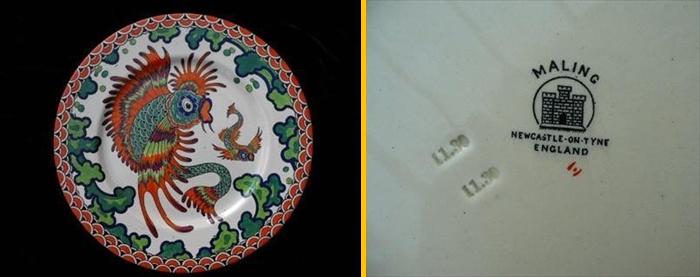
- History
- Factory Marks
- Pattern Dates
- Pattern Numbers
& Names - Newsletters
- Maling Memories Video
(free download) - A to Z Anthology
A to Z AnthologyAs the Society no longer produces newsletters, we will post occasional items of interest here. F is for FishyA correspondent writes: I am a student in New Zealand studying for a Diploma in Ceramics. I am doing some research for an essay in Art History and have chosen my subject to be on a piece of china that was given to me when my grandmother died, about 20 years ago, so it has personal interest as well. The piece has a Chinese dragon in oranges and greens and I was wondering at the significance of this. I have also included a photo of the markings on the back as I read that this may be able to tell which time period it came from. Well, the impressed numbers 11.30 tend to give us a clue, don't they? Then the seaweed border indicates something aquatic, rather than a dragon. A carp, say. Interestingly, the carp and the dragon are more closely related than we had thought. The internet informs us: "According to Chinese mythology, the Dragon's Gate is located at the top of a waterfall cascading from a legendary mountain. Many carp swim upstream against the river's strong current, but few are capable or brave enough for the final leap over the waterfall. "If a carp successfully makes the jump, it is transformed into a powerful dragon. A Chinese dragon's large, conspicuous scales indicate its origin from a carp. The Chinese dragon has long been an auspicious symbol of great and benevolent, magical power." Back to reality with a note that the mark is that of paintress Annie Fenton (long known as the "eye paintress" until her true name was discovered). An example of this pattern on a ginger jar appears as a colour plate in TMOE, although no pattern name or number is given.
We occasionally talk carp, but never its anagram.... Want more Alphabet Soup?
|
